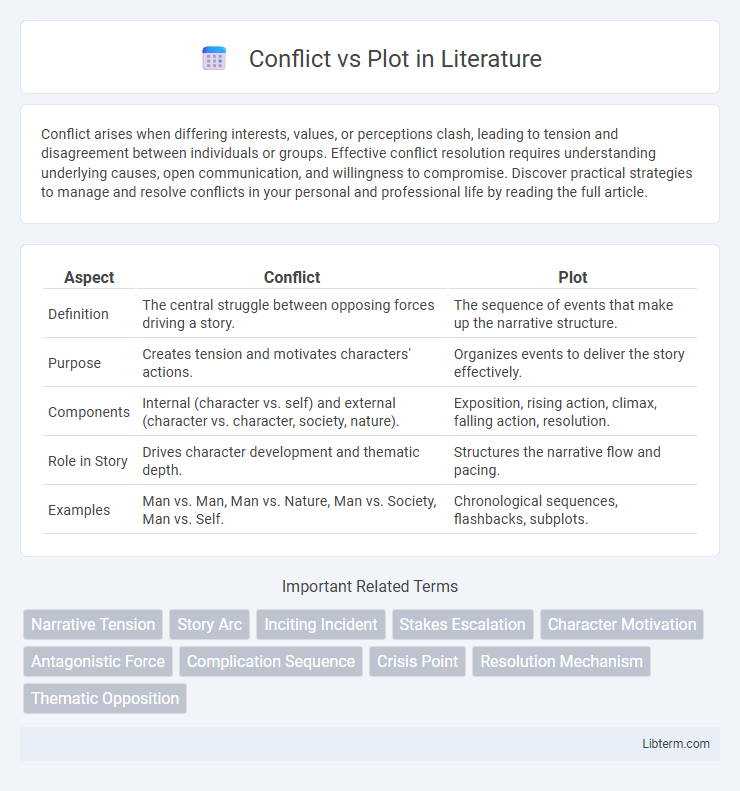Conflict arises when differing interests, values, or perceptions clash, leading to tension and disagreement between individuals or groups. Effective conflict resolution requires understanding underlying causes, open communication, and willingness to compromise. Discover practical strategies to manage and resolve conflicts in your personal and professional life by reading the full article.
Table of Comparison
| Aspect | Conflict | Plot |
|---|---|---|
| Definition | The central struggle between opposing forces driving a story. | The sequence of events that make up the narrative structure. |
| Purpose | Creates tension and motivates characters' actions. | Organizes events to deliver the story effectively. |
| Components | Internal (character vs. self) and external (character vs. character, society, nature). | Exposition, rising action, climax, falling action, resolution. |
| Role in Story | Drives character development and thematic depth. | Structures the narrative flow and pacing. |
| Examples | Man vs. Man, Man vs. Nature, Man vs. Society, Man vs. Self. | Chronological sequences, flashbacks, subplots. |
Understanding Conflict in Storytelling
Conflict drives the narrative by creating tension and motivating characters' actions, forming the foundation of any compelling plot. Understanding conflict involves recognizing internal struggles, interpersonal disputes, and external obstacles that characters face, which shape the story's progression. Effective storytelling weaves conflict seamlessly with plot elements to maintain engagement and deepen thematic resonance.
Defining Plot: Structure and Flow
Plot defines the narrative structure and flow by organizing events into a coherent sequence that drives the story forward. It consists of key elements like exposition, rising action, climax, falling action, and resolution, each contributing to the story's progression. Effective plot design maintains momentum and ensures that conflict is integrated seamlessly to engage audiences and reveal character development.
Key Differences Between Conflict and Plot
Conflict represents the central struggle or problem driving a story, often manifesting as opposition between characters, forces, or ideas, while plot refers to the structured sequence of events that unfold in the narrative. Conflict is the cause motivating the characters' actions, and plot is the chronological framework that organizes these actions to create meaning and progression. Understanding the distinction is crucial for writers aiming to develop compelling stories, as conflict fuels emotional engagement whereas plot delivers coherence and resolution.
The Role of Conflict in Developing Plot
Conflict drives the plot by creating tension and obstacles that characters must navigate, fueling the story's progression. It serves as the catalyst for character development and pivotal events, making the narrative engaging and dynamic. Without conflict, the plot stagnates, lacking the momentum needed to captivate readers or viewers.
Types of Conflict in Fiction
Types of conflict in fiction typically include man vs. man, man vs. self, man vs. nature, man vs. society, and man vs. technology, each driving the narrative through different tensions and challenges. Internal conflict (man vs. self) explores psychological struggles, while external conflicts such as man vs. society highlight clashes with cultural or institutional forces. Understanding these conflict types enhances plot development by creating dynamic situations that propel character growth and thematic depth.
How Plot Drives a Story Forward
Plot drives a story forward by structuring key events that create momentum and maintain reader engagement, ensuring a clear progression from exposition to climax and resolution. Conflict serves as the engine within the plot, generating tension and challenges that compel characters to act and evolve, deepening the narrative impact. Effective plot development weaves conflicts seamlessly into cause-and-effect sequences, transforming obstacles into pivotal turning points that enhance thematic depth and emotional resonance.
Interdependence of Conflict and Plot
Conflict serves as the driving force of a plot, creating tension and propelling the narrative forward through challenges faced by characters. The plot structures the sequence of events that arise directly from the conflict, shaping the story's progression and resolution. This interdependence ensures that conflict generates plot momentum while the plot gives conflict context and significance within the story.
Common Mistakes: Mixing Up Conflict and Plot
Many writers mistakenly confuse conflict with plot, assuming that conflict alone drives the entire story, but plot encompasses the structured sequence of events that unfold as a result of conflicts. Conflict represents the central struggle or opposition faced by characters, while plot arranges these conflicts and their resolutions into a coherent narrative arc. Clarifying the distinction between conflict as the catalyst and plot as the progression of events enhances story development and reader engagement.
Enhancing Plot Through Compelling Conflict
Compelling conflict drives plot development by creating tension and raising stakes that keep readers engaged. Well-crafted conflicts reveal character motivations and challenges, pushing the narrative forward and shaping the story's structure. Integrating multi-dimensional conflicts enhances emotional depth and ensures a more dynamic and immersive plot experience.
Examples of Conflict vs Plot in Literature
Conflict drives the tension in literature, exemplified by Shakespeare's "Romeo and Juliet," where the feud between families creates interpersonal conflict. Plot outlines the sequence of events, as seen in "The Great Gatsby," where Gatsby's pursuit of Daisy structures the narrative arc. While conflict centers on opposing forces, plot organizes these moments into a coherent story progression.
Conflict Infographic

 libterm.com
libterm.com